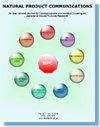硬质酮还是烯丙酮?
IF 1.4
4区 医学
Q4 CHEMISTRY, MEDICINAL
引用次数: 0
摘要
引言 perezone (1) 是一种 3- 羟基对醌,被称为在新世界中分离出的第一种天然晶体产品,而 rigidone (2) 则是从一种珊瑚物种中分离出的 4- 羟基邻醌,两者的 13C-NMR 数据基本相同。几年前,我们曾通过理论计算指出,4-羟基-1,2-醌的稳定性比 3-羟基-1,4-醌低 11 kcal/mol 以上,因此这一类醌在自然界中是共存的。在本研究中,我们将 1 和 2 的 13C-NMR 实验数据与计算方法计算出的数据进行了比较。方法使用 GIAO 和 CSGT 方法、密度泛函理论(DFT)、B3LYP/6-31 g(d,p) 和 MPW1PW91/6-31 g(d,p);以及 TPSSTPSS/cc-PVTZ 和 PBE1PBE/aug-cc-PVDZ 计算了醌环的 13C-NMR 数据。采用所述方法,在室温下于 MeOH 中实现了腙与邻苯二胺的反应。使用 Mo Kα 辐射对腙反应生成的酚嗪进行了 X 射线衍射分析。结果经过构象分析、对所发现构象的几何形状进行完全优化以及计算 1 和 2 的醌环的 13C-NMR 化学位移后,在所有情况下都观察到 1 与 2 的实验数据更加一致。结论 1 与 2 的实验数据和计算数据之间的一致性较好,加上我们之前确定的 3-hydroxy p-quinone 与 4-hydroxy o-quinone 之间的自由能差超过 11 kcal/mol,因此可以说僵化酮所描述的结构与 ent -perezone 相符。本文章由计算机程序翻译,如有差异,请以英文原文为准。
Rigidone or ent-perezone?
IntroductionThe 13 C-NMR data described for perezone (1), a 3-hydroxy p-quinone stated as the first natural product isolated as crystals in the New World, and rigidone (2), a 4-hydroxy o-quinone isolated from a coral species, are essentially the same. Some years ago, we described, using theoretical calculations, that a 4-hydroxy-1,2-quinone is more than 11 kcal/mol less stable than a 3-hydroxy-1,4-quinone making coexistence in nature of this type of quinones. In the present study, we approach the situation by comparing of the experimental 13 C-NMR data for 1 and those described for 2 with the calculated using computational methods. Additional evidence was obtained from a X-ray diffraction analysis for the reaction product of perezone with o-phenylendiamine.MethodsThe 13 C-NMR data for the quinoid rings were calculated using the GIAO and CSGT methods, density functional theory (DFT) and the functional/basis set pairs B3LYP/6-31 g(d,p) and MPW1PW91/6-31 g(d,p); and TPSSTPSS/cc-PVTZ and PBE1PBE/aug-cc-PVDZ. Perezone reaction with o-phenylenediamine was achieved using a described method in MeOH at room temperature. X-Ray diffraction analysis of phenazine from perezone reaction was done using Mo Kα radiation. The data were used to calculate the Flack parameter.ResultsAfter conformational analysis, complete optimization of the geometry of the conformers found and, calculation of the 13 C-NMR chemical shifts for the quinone ring of 1 and 2, in all cases a better agreement was observed between the experimental data for 1 versus 2. Perezone reaction with o-phenylenediamine afforded the corresponding phenazine in its amine-keto tautomeric form as evidenced from a X-ray diffraction study.ConclusionThe better agreement observed between the experimental and calculated data for 1 versus 2, along with the free energy difference of more than 11 kcal/mol in favor of the 3-hydroxy p-quinone versus 4-hydroxy o-quinone, previously established for us, allow to say that the structure described for rigidone corresponds to ent -perezone.
求助全文
通过发布文献求助,成功后即可免费获取论文全文。
去求助
来源期刊

Natural Product Communications
工程技术-食品科技
CiteScore
3.10
自引率
11.10%
发文量
254
审稿时长
2.7 months
期刊介绍:
Natural Product Communications is a peer reviewed, open access journal studying all aspects of natural products, including isolation, characterization, spectroscopic properties, biological activities, synthesis, structure-activity, biotransformation, biosynthesis, tissue culture and fermentation. It covers the full breadth of chemistry, biochemistry, biotechnology, pharmacology, and chemical ecology of natural products.
Natural Product Communications is a peer reviewed, open access journal studying all aspects of natural products, including isolation, characterization, spectroscopic properties, biological activities, synthesis, structure-activity, biotransformation, biosynthesis, tissue culture and fermentation. It covers the full breadth of chemistry, biochemistry, biotechnology, pharmacology, and chemical ecology of natural products.
Natural Product Communications is a peer reviewed, open access journal studying all aspects of natural products, including isolation, characterization, spectroscopic properties, biological activities, synthesis, structure-activity, biotransformation, biosynthesis, tissue culture and fermentation. It covers the full breadth of chemistry, biochemistry, biotechnology, pharmacology, and chemical ecology of natural products.
 求助内容:
求助内容: 应助结果提醒方式:
应助结果提醒方式:


